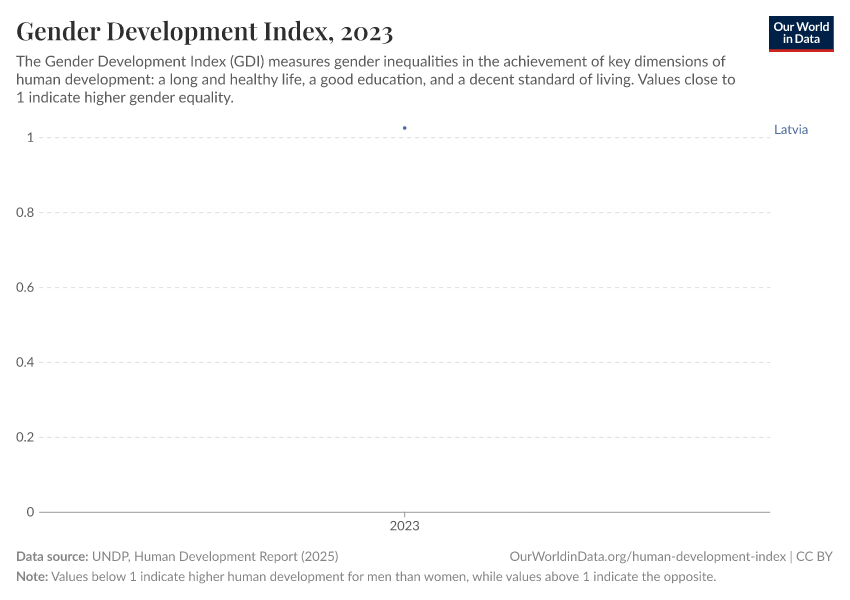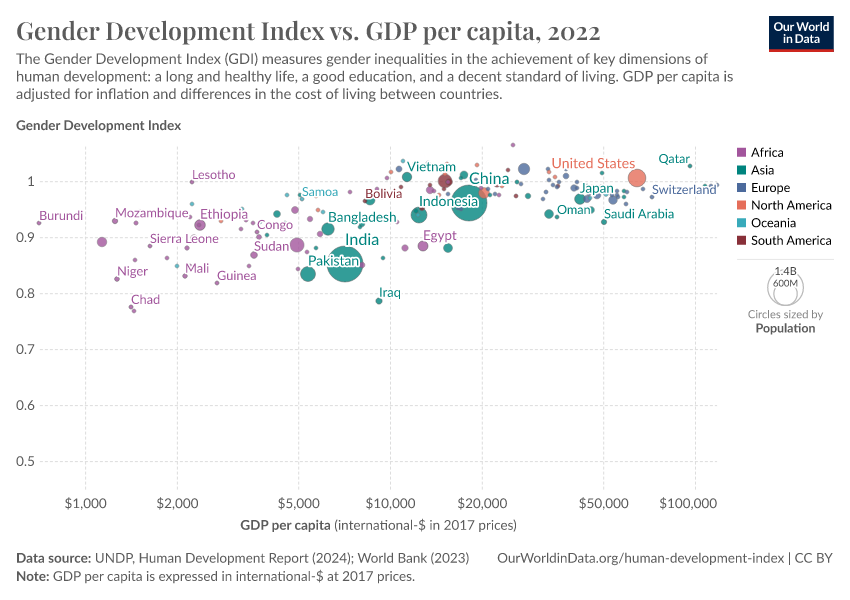Gender Development Index

What you should know about this indicator
- Compares female and male achievements in health, education and command over economic resources by taking the ratio of the female HDI to the male HDI; a value of 1 denotes gender parity, while values below (above) 1 indicate disadvantage for women (men).
- It highlights how much human development potential is lost to gender disparities and guides gender‑responsive budgeting.
- The Gender Development Index (GDI) measures gender inequalities in achievement in three basic dimensions of human development: health, measured by female and male life expectancy at birth; education, measured by female and male expected years of schooling for children and female and male mean years of schooling for adults ages 25 years and older; and command over economic resources, measured by female and male estimated earned income.
- Values below 1 indicate higher human development for men than women, while values above 1 indicate the opposite. Values close to 1 therefore indicate higher gender equality.
- Interpretable scale: an absolute deviation of, say, 5% means women's HDI is 95 % of men's (or vice-versa).
- Data is originally sourced from UNDESA life tables, DHS/MICS & UIS education surveys, ILO labour data, IMF & World Bank income statistics and HDRO wage-ratio estimates.
Related research and writing
What you should know about this indicator
- Compares female and male achievements in health, education and command over economic resources by taking the ratio of the female HDI to the male HDI; a value of 1 denotes gender parity, while values below (above) 1 indicate disadvantage for women (men).
- It highlights how much human development potential is lost to gender disparities and guides gender‑responsive budgeting.
- The Gender Development Index (GDI) measures gender inequalities in achievement in three basic dimensions of human development: health, measured by female and male life expectancy at birth; education, measured by female and male expected years of schooling for children and female and male mean years of schooling for adults ages 25 years and older; and command over economic resources, measured by female and male estimated earned income.
- Values below 1 indicate higher human development for men than women, while values above 1 indicate the opposite. Values close to 1 therefore indicate higher gender equality.
- Interpretable scale: an absolute deviation of, say, 5% means women's HDI is 95 % of men's (or vice-versa).
- Data is originally sourced from UNDESA life tables, DHS/MICS & UIS education surveys, ILO labour data, IMF & World Bank income statistics and HDRO wage-ratio estimates.
Sources and processing
This data is based on the following sources
How we process data at Our World in Data
All data and visualizations on Our World in Data rely on data sourced from one or several original data providers. Preparing this original data involves several processing steps. Depending on the data, this can include standardizing country names and world region definitions, converting units, calculating derived indicators such as per capita measures, as well as adding or adapting metadata such as the name or the description given to an indicator.
At the link below you can find a detailed description of the structure of our data pipeline, including links to all the code used to prepare data across Our World in Data.
Notes on our processing step for this indicator
We calculated averages over continents and income groups by taking the population-weighted average of the countries in each group. If less than 80% of countries in an area report data for a given year, we do not calculate the average for that area.
Reuse this work
- All data produced by third-party providers and made available by Our World in Data are subject to the license terms from the original providers. Our work would not be possible without the data providers we rely on, so we ask you to always cite them appropriately (see below). This is crucial to allow data providers to continue doing their work, enhancing, maintaining and updating valuable data.
- All data, visualizations, and code produced by Our World in Data are completely open access under the Creative Commons BY license. You have the permission to use, distribute, and reproduce these in any medium, provided the source and authors are credited.
Citations
How to cite this page
To cite this page overall, including any descriptions, FAQs or explanations of the data authored by Our World in Data, please use the following citation:
“Data Page: Gender Development Index”. Our World in Data (2025). Data adapted from UNDP, Human Development Report. Retrieved from https://archive.ourworldindata.org/20251209-133038/grapher/gender-development-index.html [online resource] (archived on December 9, 2025).How to cite this data
In-line citationIf you have limited space (e.g. in data visualizations), you can use this abbreviated in-line citation:
UNDP, Human Development Report (2025) – with minor processing by Our World in DataFull citation
UNDP, Human Development Report (2025) – with minor processing by Our World in Data. “Gender Development Index – UNDP” [dataset]. UNDP, Human Development Report, “Human Development Report” [original data]. Retrieved December 22, 2025 from https://archive.ourworldindata.org/20251209-133038/grapher/gender-development-index.html (archived on December 9, 2025).
